Introductory Economics Assignment: Market Structures and Policies
VerifiedAdded on 2023/06/05
|13
|1916
|499
Homework Assignment
AI Summary
This microeconomics assignment analyzes the impact of free trade, import quotas, and export subsidies on the Australian and Canadian economies. The assignment explores how these policies affect consumer and producer surplus, as well as overall welfare. It further examines the espresso coffee market, classifying it as monopolistically competitive and investigating factors contributing to its growth. The solution includes demand-supply models, illustrating the effects of changes in demand, and the long-run profitability of firms under monopolistic competition. The assignment also explores the effects of government subsidies on market prices, firm profits, and overall market dynamics. The analysis provides a comprehensive understanding of microeconomic principles and their practical implications in real-world scenarios.
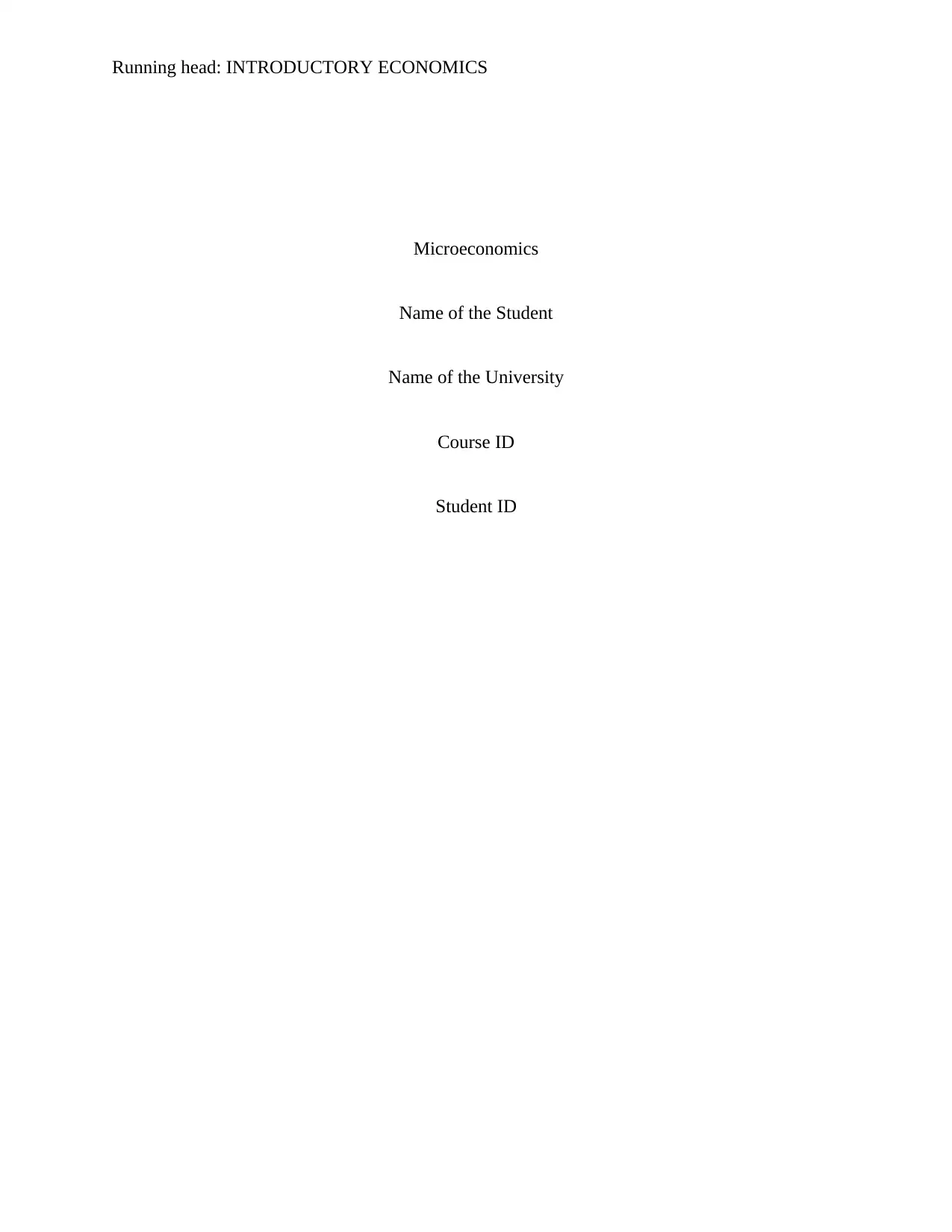
Running head: INTRODUCTORY ECONOMICS
Microeconomics
Name of the Student
Name of the University
Course ID
Student ID
Microeconomics
Name of the Student
Name of the University
Course ID
Student ID
Paraphrase This Document
Need a fresh take? Get an instant paraphrase of this document with our AI Paraphraser
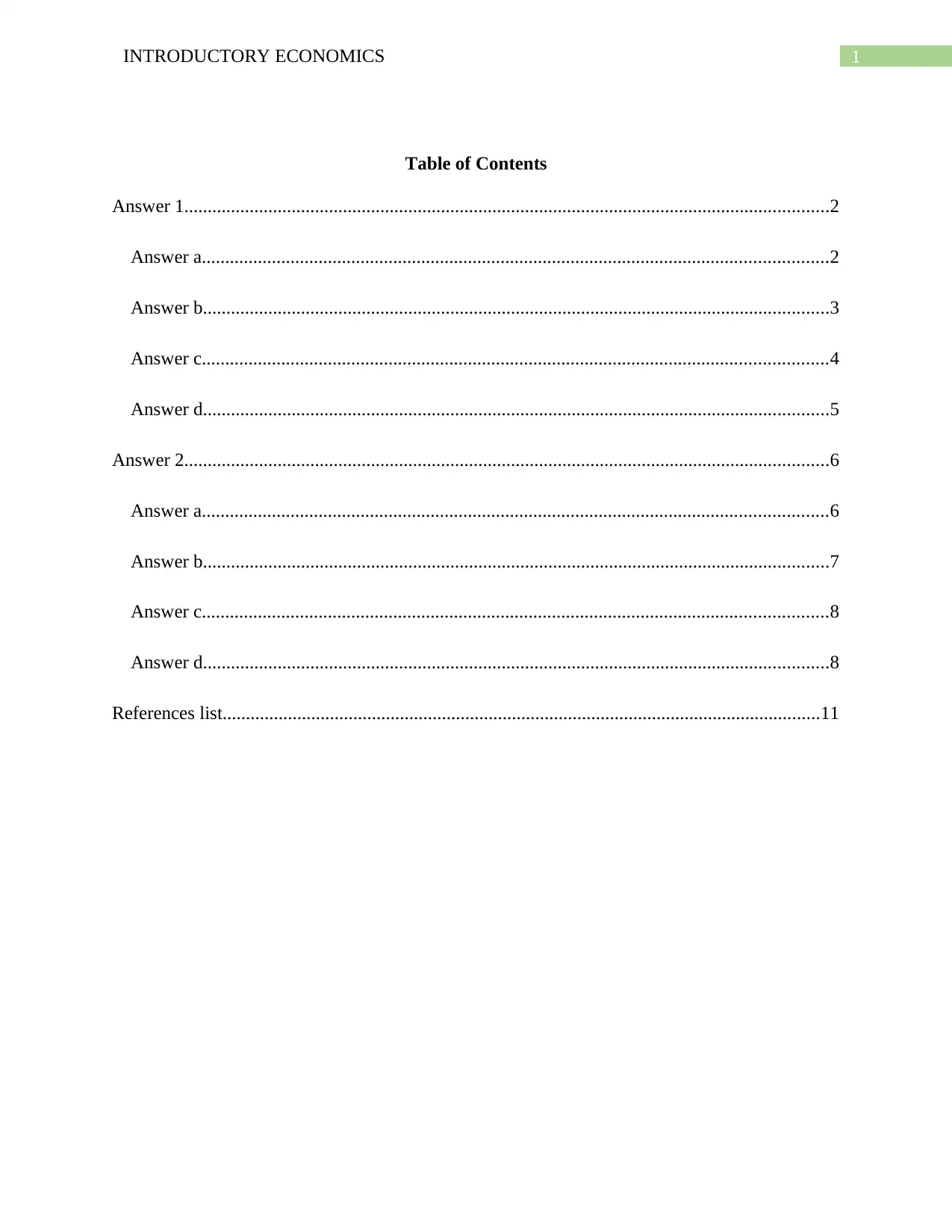
1INTRODUCTORY ECONOMICS
Table of Contents
Answer 1..........................................................................................................................................2
Answer a......................................................................................................................................2
Answer b......................................................................................................................................3
Answer c......................................................................................................................................4
Answer d......................................................................................................................................5
Answer 2..........................................................................................................................................6
Answer a......................................................................................................................................6
Answer b......................................................................................................................................7
Answer c......................................................................................................................................8
Answer d......................................................................................................................................8
References list................................................................................................................................11
Table of Contents
Answer 1..........................................................................................................................................2
Answer a......................................................................................................................................2
Answer b......................................................................................................................................3
Answer c......................................................................................................................................4
Answer d......................................................................................................................................5
Answer 2..........................................................................................................................................6
Answer a......................................................................................................................................6
Answer b......................................................................................................................................7
Answer c......................................................................................................................................8
Answer d......................................................................................................................................8
References list................................................................................................................................11
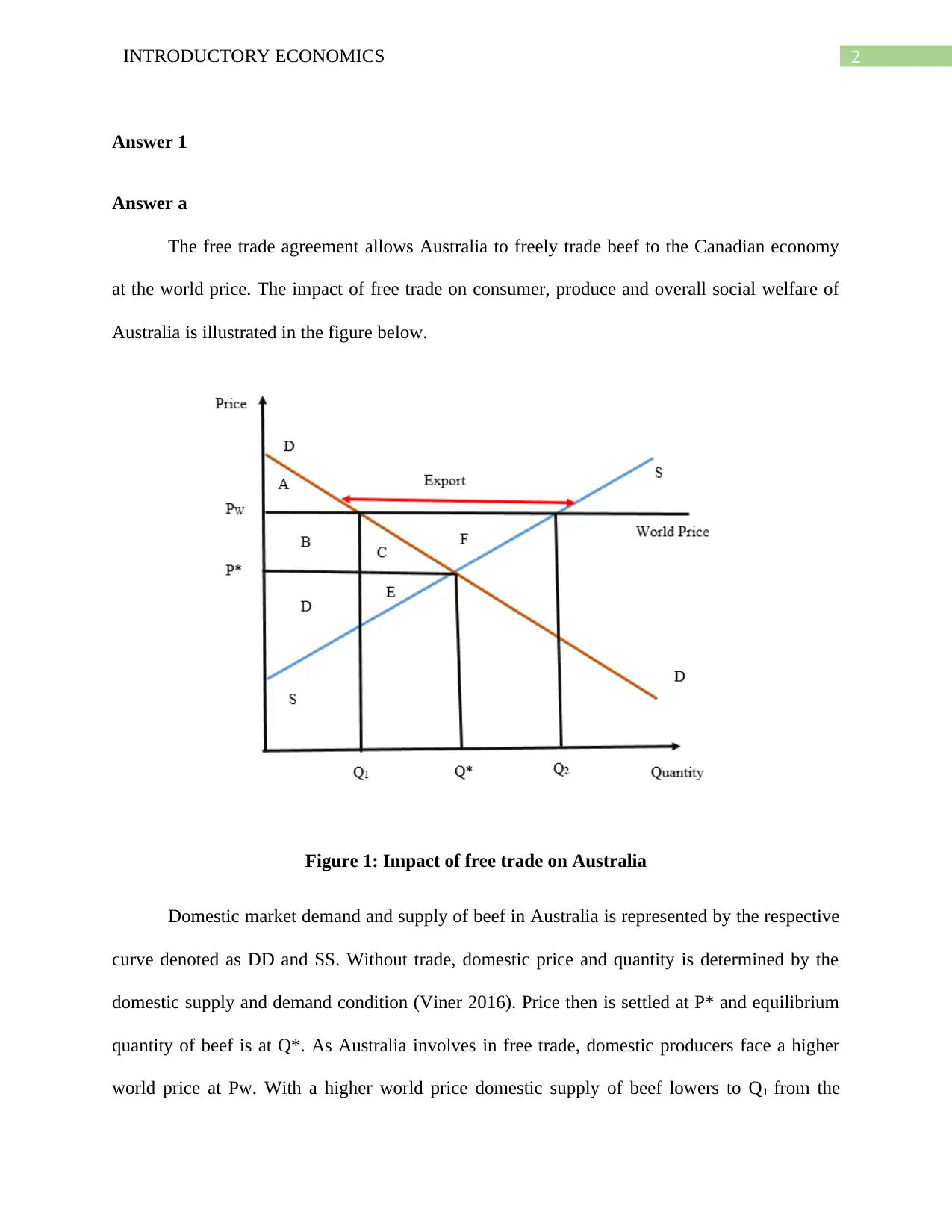
2INTRODUCTORY ECONOMICS
Answer 1
Answer a
The free trade agreement allows Australia to freely trade beef to the Canadian economy
at the world price. The impact of free trade on consumer, produce and overall social welfare of
Australia is illustrated in the figure below.
Figure 1: Impact of free trade on Australia
Domestic market demand and supply of beef in Australia is represented by the respective
curve denoted as DD and SS. Without trade, domestic price and quantity is determined by the
domestic supply and demand condition (Viner 2016). Price then is settled at P* and equilibrium
quantity of beef is at Q*. As Australia involves in free trade, domestic producers face a higher
world price at Pw. With a higher world price domestic supply of beef lowers to Q1 from the
Answer 1
Answer a
The free trade agreement allows Australia to freely trade beef to the Canadian economy
at the world price. The impact of free trade on consumer, produce and overall social welfare of
Australia is illustrated in the figure below.
Figure 1: Impact of free trade on Australia
Domestic market demand and supply of beef in Australia is represented by the respective
curve denoted as DD and SS. Without trade, domestic price and quantity is determined by the
domestic supply and demand condition (Viner 2016). Price then is settled at P* and equilibrium
quantity of beef is at Q*. As Australia involves in free trade, domestic producers face a higher
world price at Pw. With a higher world price domestic supply of beef lowers to Q1 from the
⊘ This is a preview!⊘
Do you want full access?
Subscribe today to unlock all pages.

Trusted by 1+ million students worldwide
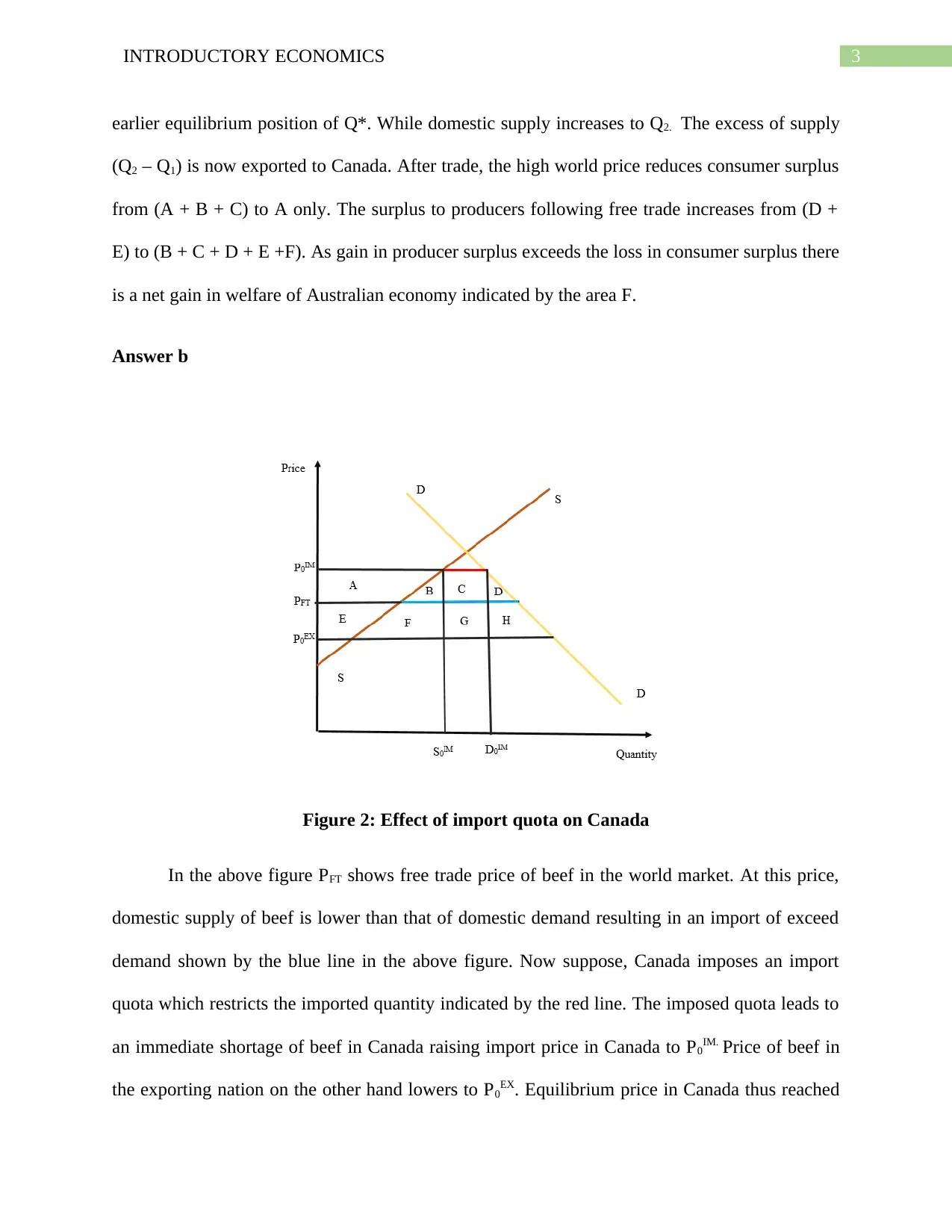
3INTRODUCTORY ECONOMICS
earlier equilibrium position of Q*. While domestic supply increases to Q2. The excess of supply
(Q2 – Q1) is now exported to Canada. After trade, the high world price reduces consumer surplus
from (A + B + C) to A only. The surplus to producers following free trade increases from (D +
E) to (B + C + D + E +F). As gain in producer surplus exceeds the loss in consumer surplus there
is a net gain in welfare of Australian economy indicated by the area F.
Answer b
Figure 2: Effect of import quota on Canada
In the above figure PFT shows free trade price of beef in the world market. At this price,
domestic supply of beef is lower than that of domestic demand resulting in an import of exceed
demand shown by the blue line in the above figure. Now suppose, Canada imposes an import
quota which restricts the imported quantity indicated by the red line. The imposed quota leads to
an immediate shortage of beef in Canada raising import price in Canada to P0IM. Price of beef in
the exporting nation on the other hand lowers to P0EX. Equilibrium price in Canada thus reached
earlier equilibrium position of Q*. While domestic supply increases to Q2. The excess of supply
(Q2 – Q1) is now exported to Canada. After trade, the high world price reduces consumer surplus
from (A + B + C) to A only. The surplus to producers following free trade increases from (D +
E) to (B + C + D + E +F). As gain in producer surplus exceeds the loss in consumer surplus there
is a net gain in welfare of Australian economy indicated by the area F.
Answer b
Figure 2: Effect of import quota on Canada
In the above figure PFT shows free trade price of beef in the world market. At this price,
domestic supply of beef is lower than that of domestic demand resulting in an import of exceed
demand shown by the blue line in the above figure. Now suppose, Canada imposes an import
quota which restricts the imported quantity indicated by the red line. The imposed quota leads to
an immediate shortage of beef in Canada raising import price in Canada to P0IM. Price of beef in
the exporting nation on the other hand lowers to P0EX. Equilibrium price in Canada thus reached
Paraphrase This Document
Need a fresh take? Get an instant paraphrase of this document with our AI Paraphraser
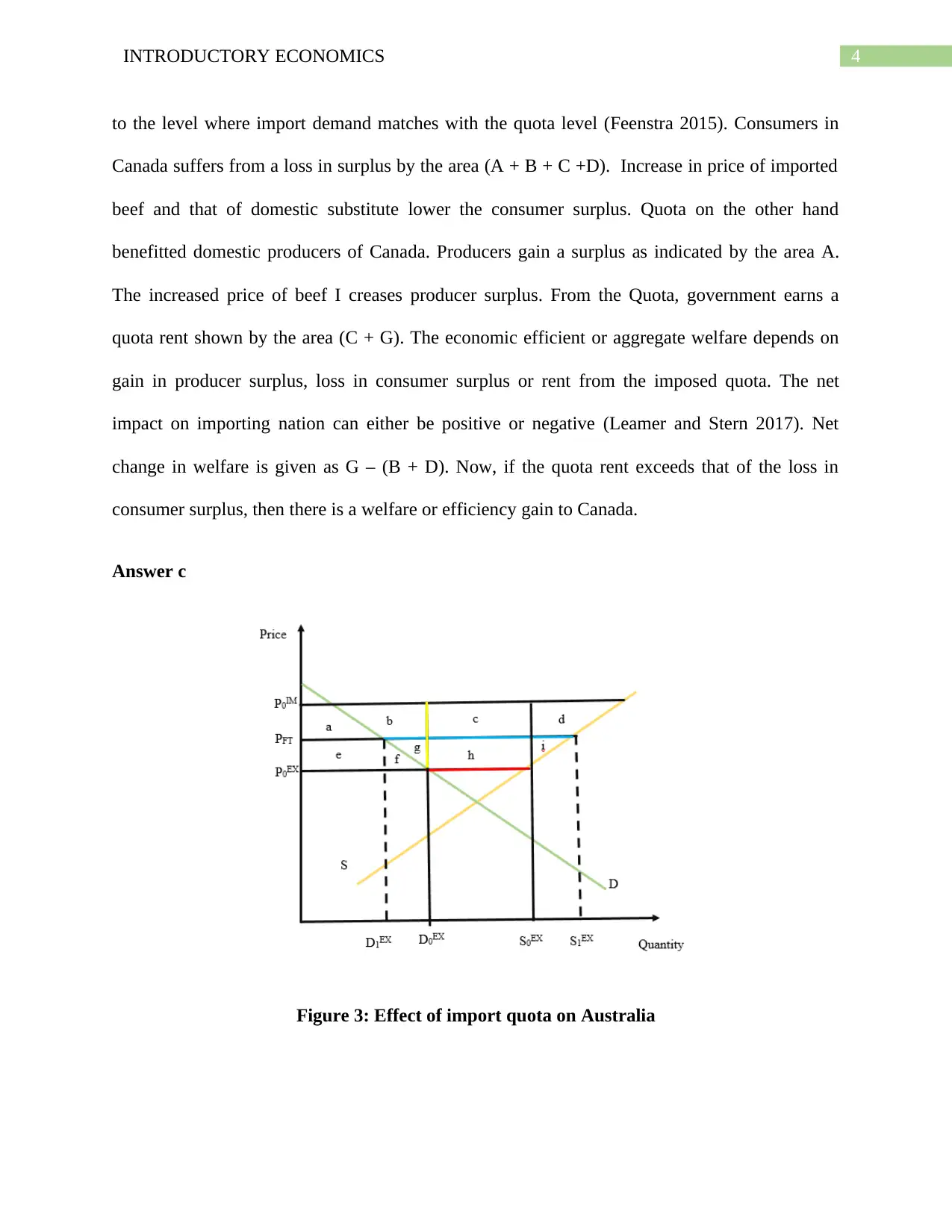
4INTRODUCTORY ECONOMICS
to the level where import demand matches with the quota level (Feenstra 2015). Consumers in
Canada suffers from a loss in surplus by the area (A + B + C +D). Increase in price of imported
beef and that of domestic substitute lower the consumer surplus. Quota on the other hand
benefitted domestic producers of Canada. Producers gain a surplus as indicated by the area A.
The increased price of beef I creases producer surplus. From the Quota, government earns a
quota rent shown by the area (C + G). The economic efficient or aggregate welfare depends on
gain in producer surplus, loss in consumer surplus or rent from the imposed quota. The net
impact on importing nation can either be positive or negative (Leamer and Stern 2017). Net
change in welfare is given as G – (B + D). Now, if the quota rent exceeds that of the loss in
consumer surplus, then there is a welfare or efficiency gain to Canada.
Answer c
Figure 3: Effect of import quota on Australia
to the level where import demand matches with the quota level (Feenstra 2015). Consumers in
Canada suffers from a loss in surplus by the area (A + B + C +D). Increase in price of imported
beef and that of domestic substitute lower the consumer surplus. Quota on the other hand
benefitted domestic producers of Canada. Producers gain a surplus as indicated by the area A.
The increased price of beef I creases producer surplus. From the Quota, government earns a
quota rent shown by the area (C + G). The economic efficient or aggregate welfare depends on
gain in producer surplus, loss in consumer surplus or rent from the imposed quota. The net
impact on importing nation can either be positive or negative (Leamer and Stern 2017). Net
change in welfare is given as G – (B + D). Now, if the quota rent exceeds that of the loss in
consumer surplus, then there is a welfare or efficiency gain to Canada.
Answer c
Figure 3: Effect of import quota on Australia
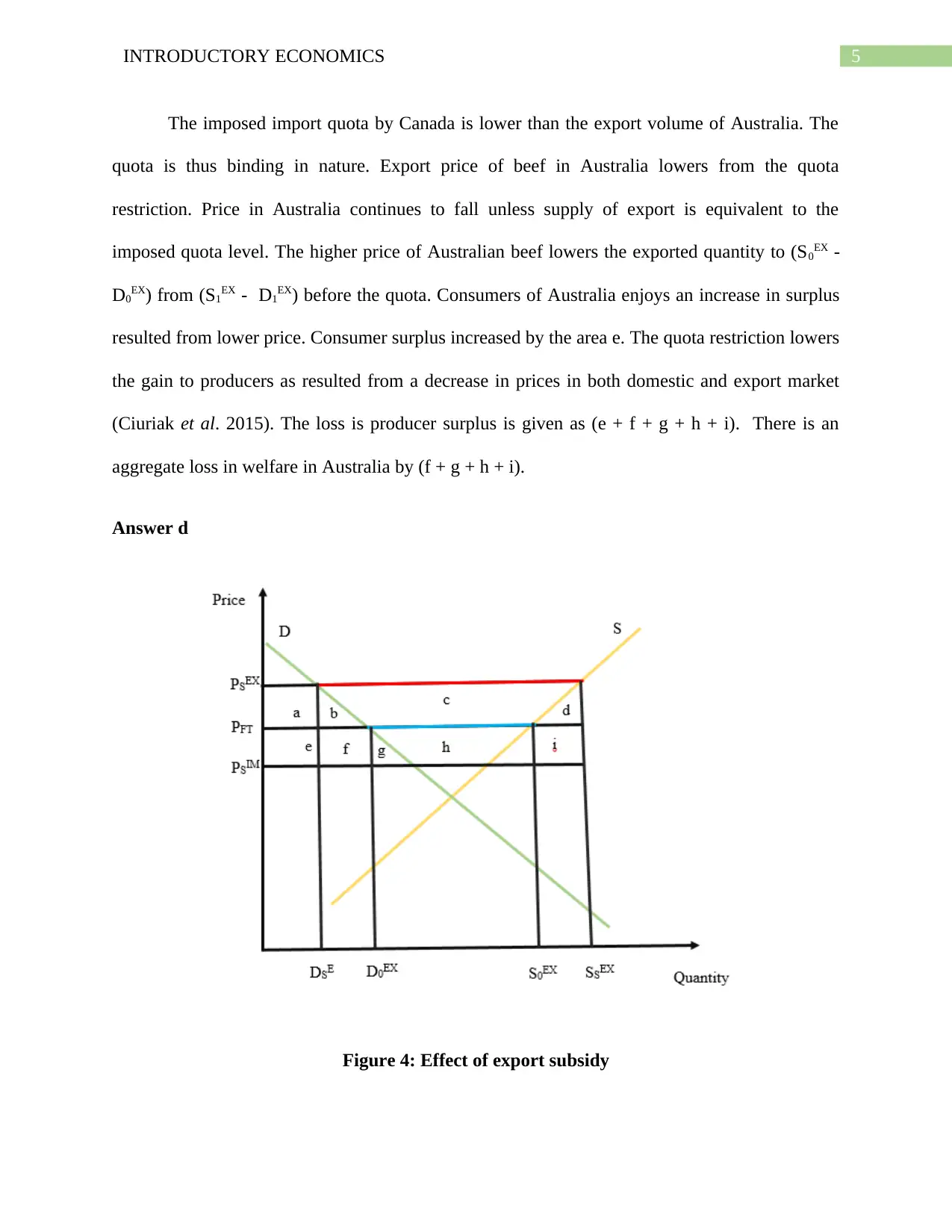
5INTRODUCTORY ECONOMICS
The imposed import quota by Canada is lower than the export volume of Australia. The
quota is thus binding in nature. Export price of beef in Australia lowers from the quota
restriction. Price in Australia continues to fall unless supply of export is equivalent to the
imposed quota level. The higher price of Australian beef lowers the exported quantity to (S0EX -
D0EX) from (S1EX - D1EX) before the quota. Consumers of Australia enjoys an increase in surplus
resulted from lower price. Consumer surplus increased by the area e. The quota restriction lowers
the gain to producers as resulted from a decrease in prices in both domestic and export market
(Ciuriak et al. 2015). The loss is producer surplus is given as (e + f + g + h + i). There is an
aggregate loss in welfare in Australia by (f + g + h + i).
Answer d
Figure 4: Effect of export subsidy
The imposed import quota by Canada is lower than the export volume of Australia. The
quota is thus binding in nature. Export price of beef in Australia lowers from the quota
restriction. Price in Australia continues to fall unless supply of export is equivalent to the
imposed quota level. The higher price of Australian beef lowers the exported quantity to (S0EX -
D0EX) from (S1EX - D1EX) before the quota. Consumers of Australia enjoys an increase in surplus
resulted from lower price. Consumer surplus increased by the area e. The quota restriction lowers
the gain to producers as resulted from a decrease in prices in both domestic and export market
(Ciuriak et al. 2015). The loss is producer surplus is given as (e + f + g + h + i). There is an
aggregate loss in welfare in Australia by (f + g + h + i).
Answer d
Figure 4: Effect of export subsidy
⊘ This is a preview!⊘
Do you want full access?
Subscribe today to unlock all pages.

Trusted by 1+ million students worldwide
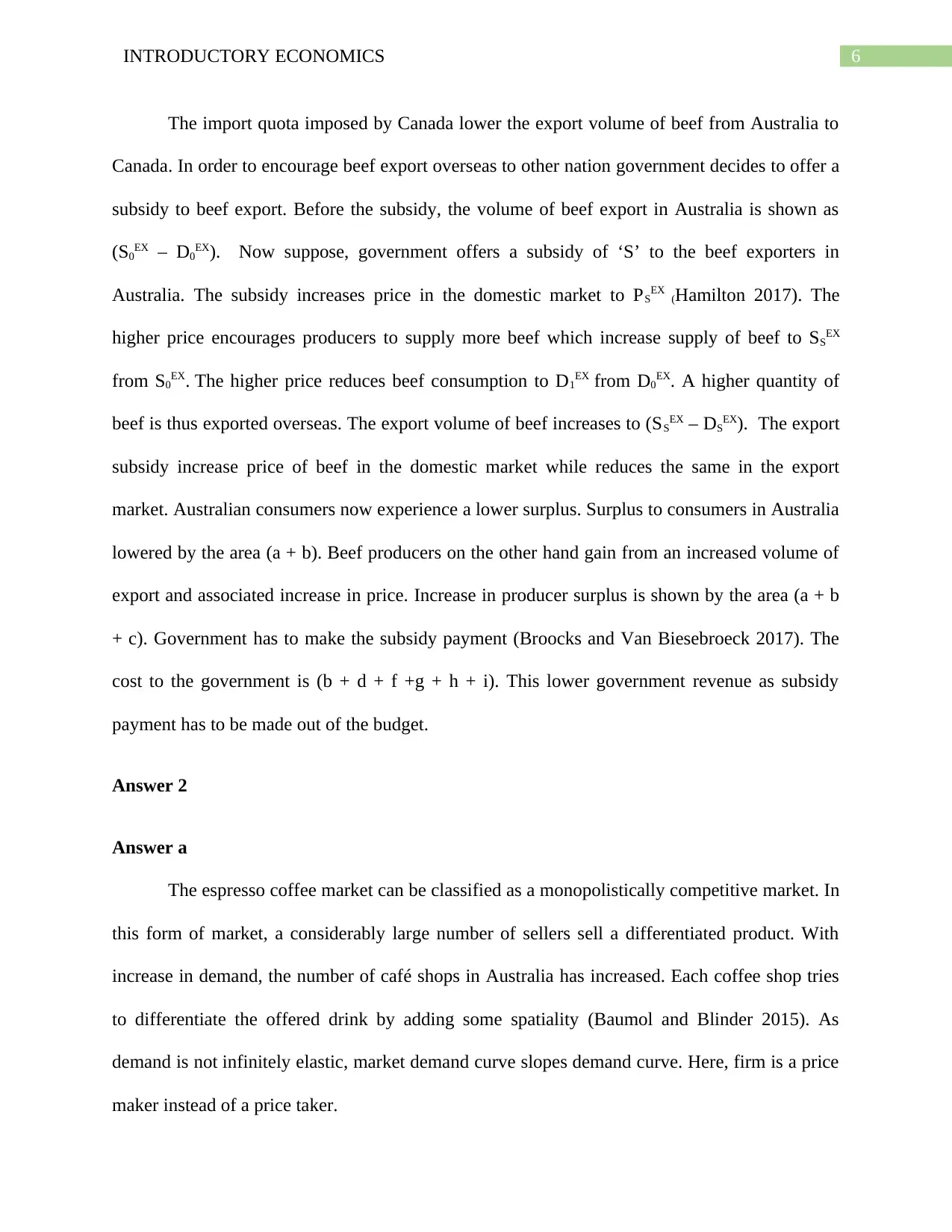
6INTRODUCTORY ECONOMICS
The import quota imposed by Canada lower the export volume of beef from Australia to
Canada. In order to encourage beef export overseas to other nation government decides to offer a
subsidy to beef export. Before the subsidy, the volume of beef export in Australia is shown as
(S0EX – D0EX). Now suppose, government offers a subsidy of ‘S’ to the beef exporters in
Australia. The subsidy increases price in the domestic market to PSEX (Hamilton 2017). The
higher price encourages producers to supply more beef which increase supply of beef to SSEX
from S0EX. The higher price reduces beef consumption to D1EX from D0EX. A higher quantity of
beef is thus exported overseas. The export volume of beef increases to (SSEX – DSEX). The export
subsidy increase price of beef in the domestic market while reduces the same in the export
market. Australian consumers now experience a lower surplus. Surplus to consumers in Australia
lowered by the area (a + b). Beef producers on the other hand gain from an increased volume of
export and associated increase in price. Increase in producer surplus is shown by the area (a + b
+ c). Government has to make the subsidy payment (Broocks and Van Biesebroeck 2017). The
cost to the government is (b + d + f +g + h + i). This lower government revenue as subsidy
payment has to be made out of the budget.
Answer 2
Answer a
The espresso coffee market can be classified as a monopolistically competitive market. In
this form of market, a considerably large number of sellers sell a differentiated product. With
increase in demand, the number of café shops in Australia has increased. Each coffee shop tries
to differentiate the offered drink by adding some spatiality (Baumol and Blinder 2015). As
demand is not infinitely elastic, market demand curve slopes demand curve. Here, firm is a price
maker instead of a price taker.
The import quota imposed by Canada lower the export volume of beef from Australia to
Canada. In order to encourage beef export overseas to other nation government decides to offer a
subsidy to beef export. Before the subsidy, the volume of beef export in Australia is shown as
(S0EX – D0EX). Now suppose, government offers a subsidy of ‘S’ to the beef exporters in
Australia. The subsidy increases price in the domestic market to PSEX (Hamilton 2017). The
higher price encourages producers to supply more beef which increase supply of beef to SSEX
from S0EX. The higher price reduces beef consumption to D1EX from D0EX. A higher quantity of
beef is thus exported overseas. The export volume of beef increases to (SSEX – DSEX). The export
subsidy increase price of beef in the domestic market while reduces the same in the export
market. Australian consumers now experience a lower surplus. Surplus to consumers in Australia
lowered by the area (a + b). Beef producers on the other hand gain from an increased volume of
export and associated increase in price. Increase in producer surplus is shown by the area (a + b
+ c). Government has to make the subsidy payment (Broocks and Van Biesebroeck 2017). The
cost to the government is (b + d + f +g + h + i). This lower government revenue as subsidy
payment has to be made out of the budget.
Answer 2
Answer a
The espresso coffee market can be classified as a monopolistically competitive market. In
this form of market, a considerably large number of sellers sell a differentiated product. With
increase in demand, the number of café shops in Australia has increased. Each coffee shop tries
to differentiate the offered drink by adding some spatiality (Baumol and Blinder 2015). As
demand is not infinitely elastic, market demand curve slopes demand curve. Here, firm is a price
maker instead of a price taker.
Paraphrase This Document
Need a fresh take? Get an instant paraphrase of this document with our AI Paraphraser
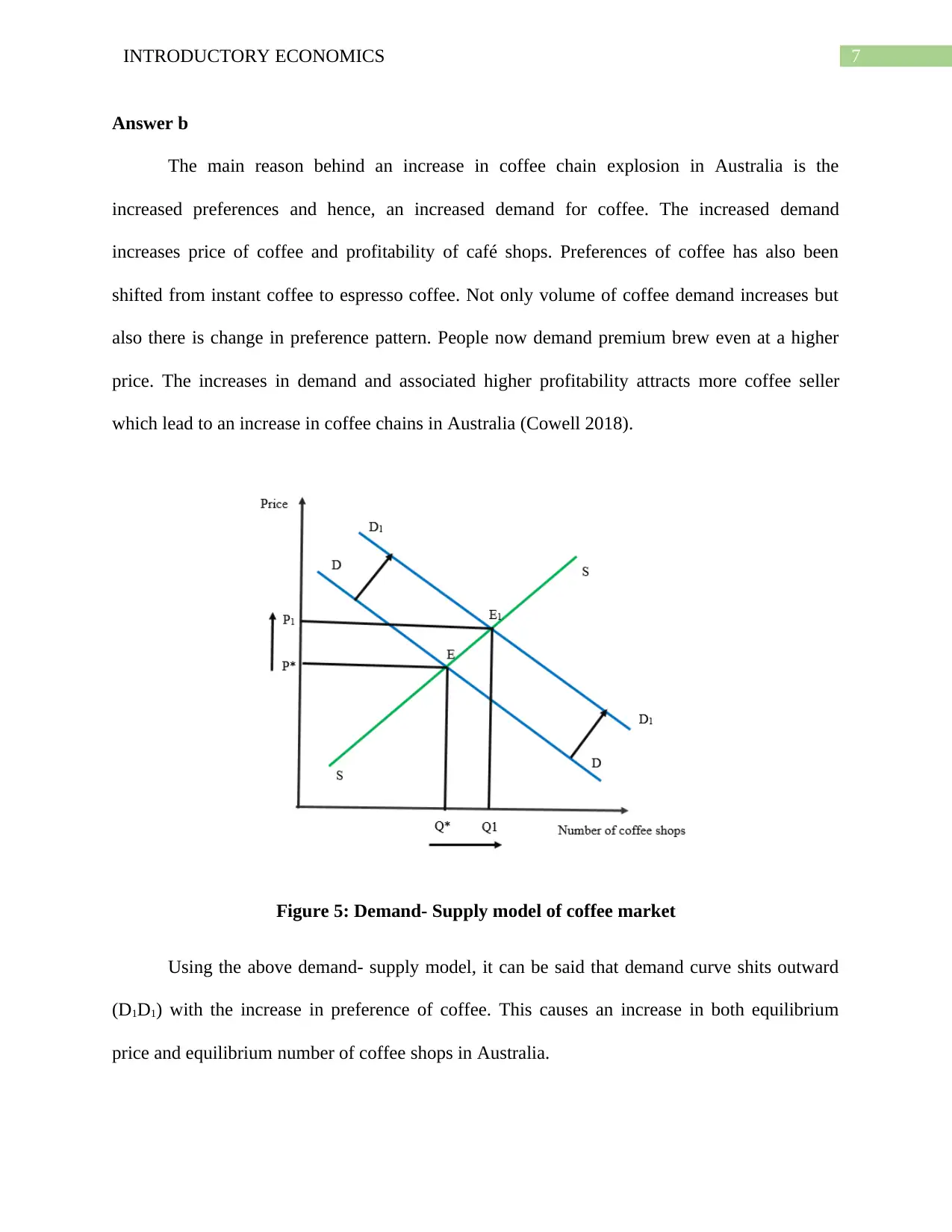
7INTRODUCTORY ECONOMICS
Answer b
The main reason behind an increase in coffee chain explosion in Australia is the
increased preferences and hence, an increased demand for coffee. The increased demand
increases price of coffee and profitability of café shops. Preferences of coffee has also been
shifted from instant coffee to espresso coffee. Not only volume of coffee demand increases but
also there is change in preference pattern. People now demand premium brew even at a higher
price. The increases in demand and associated higher profitability attracts more coffee seller
which lead to an increase in coffee chains in Australia (Cowell 2018).
Figure 5: Demand- Supply model of coffee market
Using the above demand- supply model, it can be said that demand curve shits outward
(D1D1) with the increase in preference of coffee. This causes an increase in both equilibrium
price and equilibrium number of coffee shops in Australia.
Answer b
The main reason behind an increase in coffee chain explosion in Australia is the
increased preferences and hence, an increased demand for coffee. The increased demand
increases price of coffee and profitability of café shops. Preferences of coffee has also been
shifted from instant coffee to espresso coffee. Not only volume of coffee demand increases but
also there is change in preference pattern. People now demand premium brew even at a higher
price. The increases in demand and associated higher profitability attracts more coffee seller
which lead to an increase in coffee chains in Australia (Cowell 2018).
Figure 5: Demand- Supply model of coffee market
Using the above demand- supply model, it can be said that demand curve shits outward
(D1D1) with the increase in preference of coffee. This causes an increase in both equilibrium
price and equilibrium number of coffee shops in Australia.
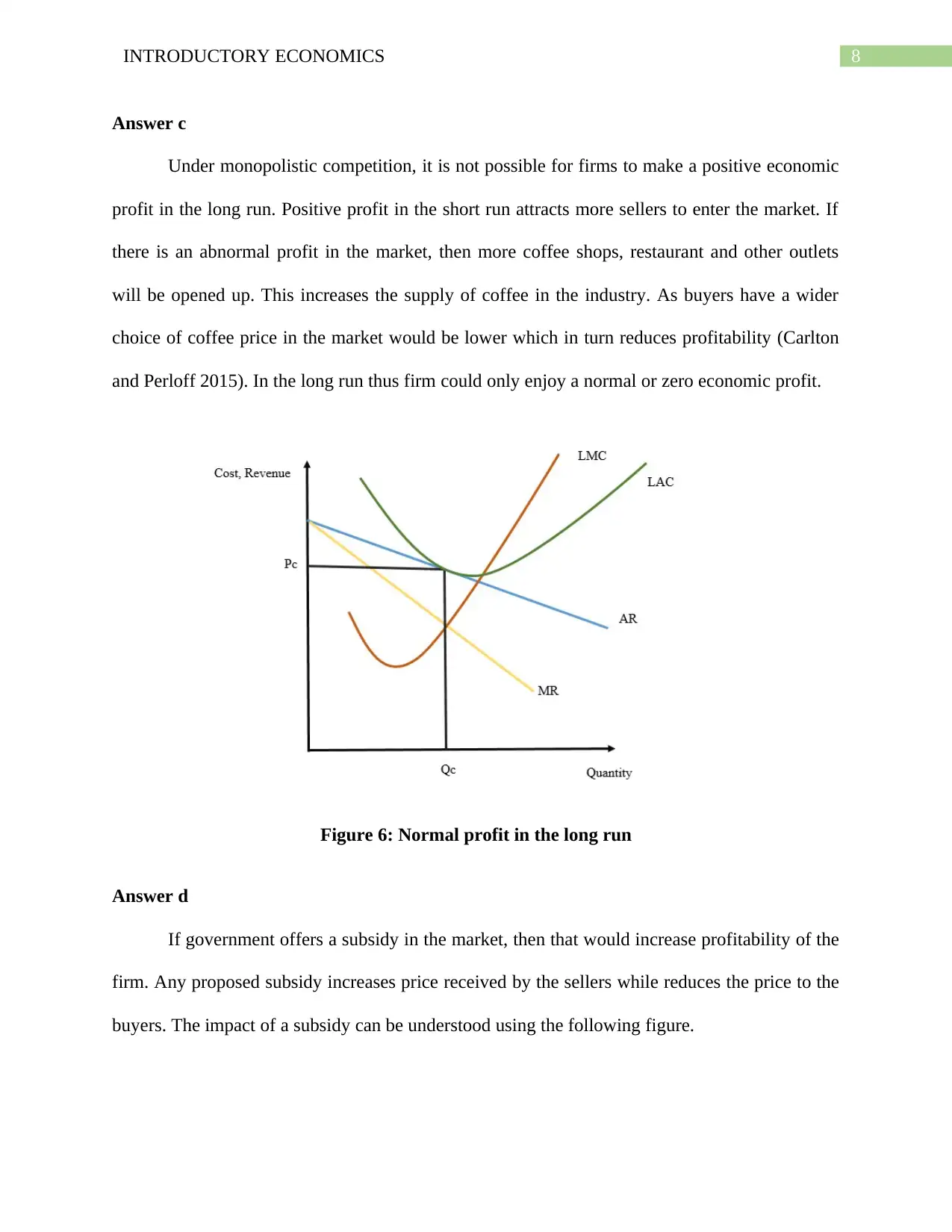
8INTRODUCTORY ECONOMICS
Answer c
Under monopolistic competition, it is not possible for firms to make a positive economic
profit in the long run. Positive profit in the short run attracts more sellers to enter the market. If
there is an abnormal profit in the market, then more coffee shops, restaurant and other outlets
will be opened up. This increases the supply of coffee in the industry. As buyers have a wider
choice of coffee price in the market would be lower which in turn reduces profitability (Carlton
and Perloff 2015). In the long run thus firm could only enjoy a normal or zero economic profit.
Figure 6: Normal profit in the long run
Answer d
If government offers a subsidy in the market, then that would increase profitability of the
firm. Any proposed subsidy increases price received by the sellers while reduces the price to the
buyers. The impact of a subsidy can be understood using the following figure.
Answer c
Under monopolistic competition, it is not possible for firms to make a positive economic
profit in the long run. Positive profit in the short run attracts more sellers to enter the market. If
there is an abnormal profit in the market, then more coffee shops, restaurant and other outlets
will be opened up. This increases the supply of coffee in the industry. As buyers have a wider
choice of coffee price in the market would be lower which in turn reduces profitability (Carlton
and Perloff 2015). In the long run thus firm could only enjoy a normal or zero economic profit.
Figure 6: Normal profit in the long run
Answer d
If government offers a subsidy in the market, then that would increase profitability of the
firm. Any proposed subsidy increases price received by the sellers while reduces the price to the
buyers. The impact of a subsidy can be understood using the following figure.
⊘ This is a preview!⊘
Do you want full access?
Subscribe today to unlock all pages.

Trusted by 1+ million students worldwide
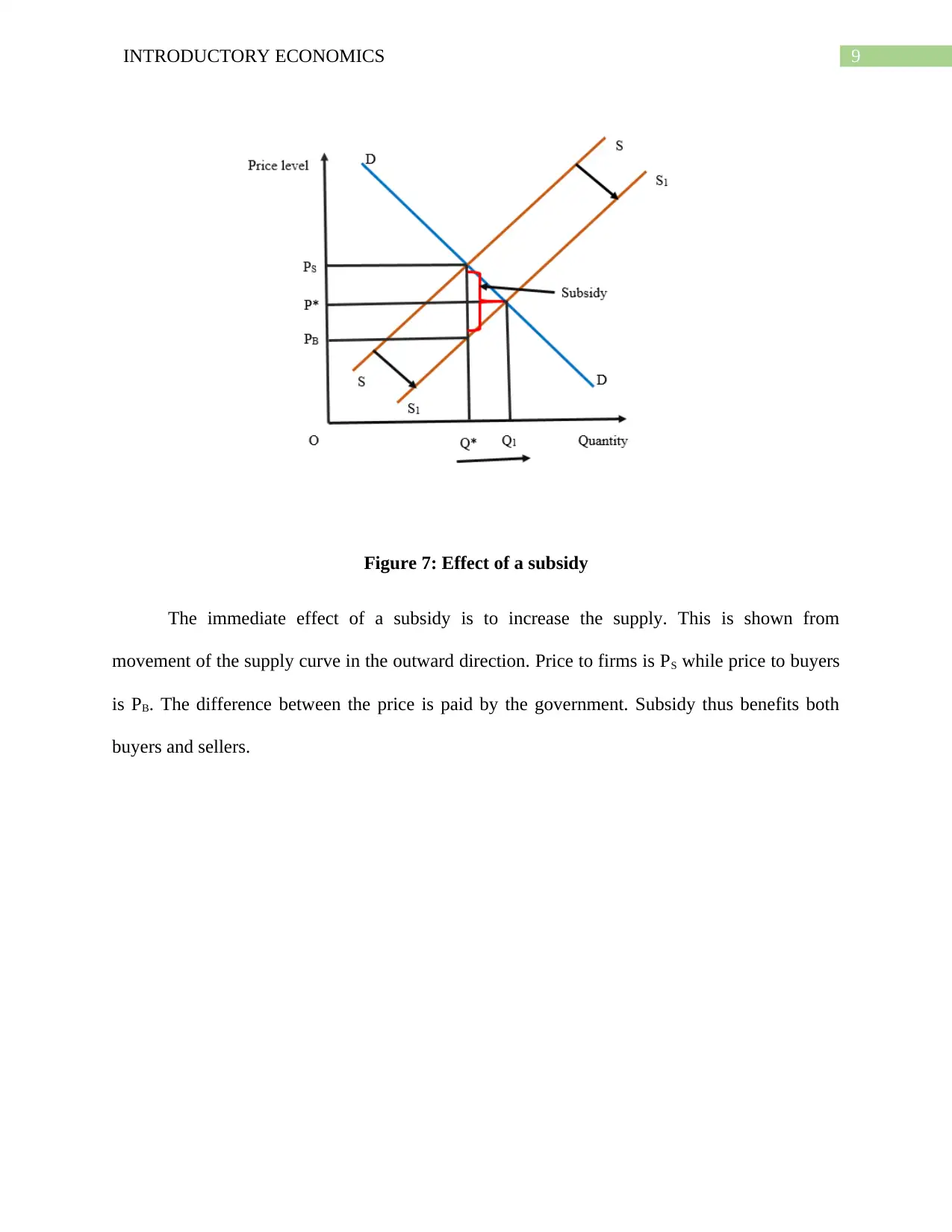
9INTRODUCTORY ECONOMICS
Figure 7: Effect of a subsidy
The immediate effect of a subsidy is to increase the supply. This is shown from
movement of the supply curve in the outward direction. Price to firms is PS while price to buyers
is PB. The difference between the price is paid by the government. Subsidy thus benefits both
buyers and sellers.
Figure 7: Effect of a subsidy
The immediate effect of a subsidy is to increase the supply. This is shown from
movement of the supply curve in the outward direction. Price to firms is PS while price to buyers
is PB. The difference between the price is paid by the government. Subsidy thus benefits both
buyers and sellers.
Paraphrase This Document
Need a fresh take? Get an instant paraphrase of this document with our AI Paraphraser
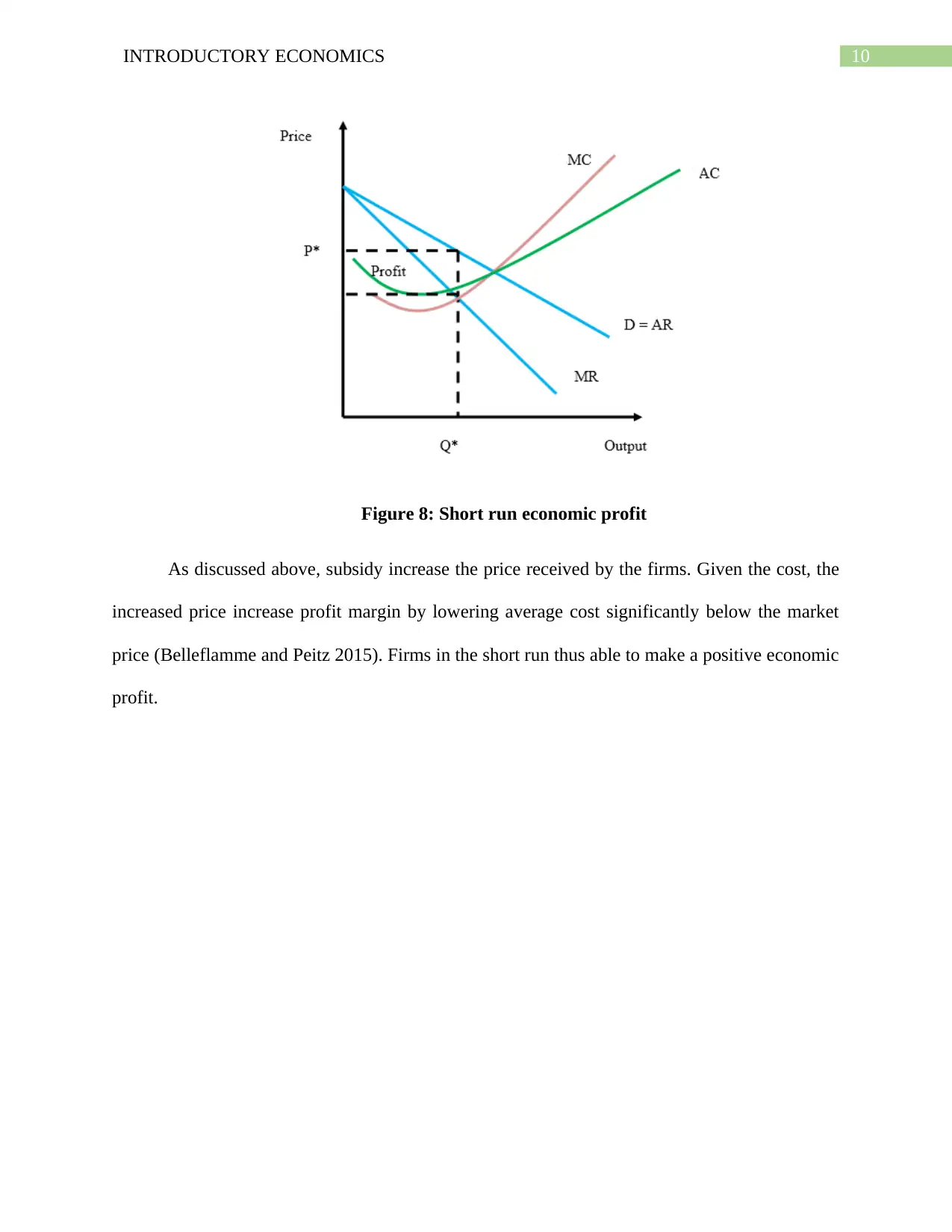
10INTRODUCTORY ECONOMICS
Figure 8: Short run economic profit
As discussed above, subsidy increase the price received by the firms. Given the cost, the
increased price increase profit margin by lowering average cost significantly below the market
price (Belleflamme and Peitz 2015). Firms in the short run thus able to make a positive economic
profit.
Figure 8: Short run economic profit
As discussed above, subsidy increase the price received by the firms. Given the cost, the
increased price increase profit margin by lowering average cost significantly below the market
price (Belleflamme and Peitz 2015). Firms in the short run thus able to make a positive economic
profit.
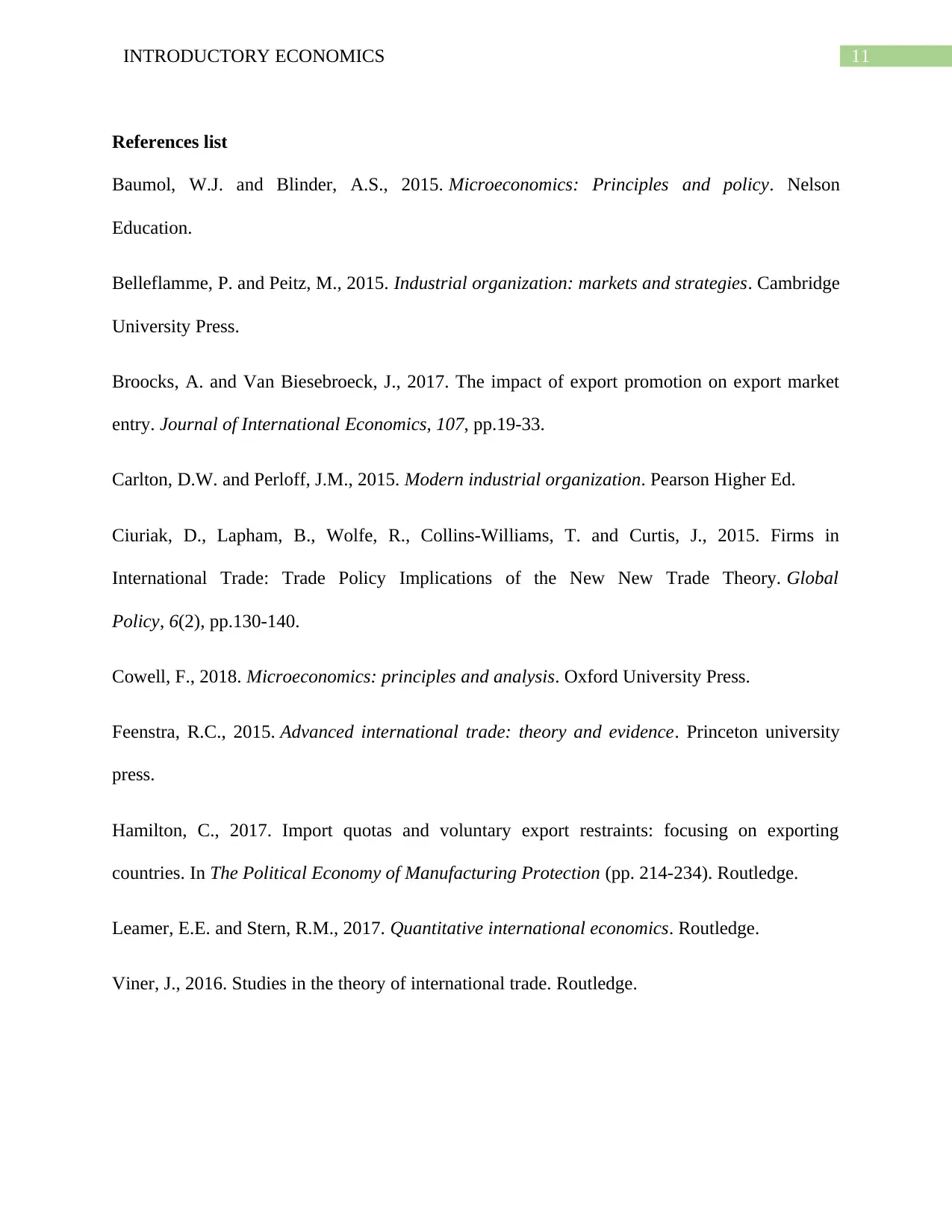
11INTRODUCTORY ECONOMICS
References list
Baumol, W.J. and Blinder, A.S., 2015. Microeconomics: Principles and policy. Nelson
Education.
Belleflamme, P. and Peitz, M., 2015. Industrial organization: markets and strategies. Cambridge
University Press.
Broocks, A. and Van Biesebroeck, J., 2017. The impact of export promotion on export market
entry. Journal of International Economics, 107, pp.19-33.
Carlton, D.W. and Perloff, J.M., 2015. Modern industrial organization. Pearson Higher Ed.
Ciuriak, D., Lapham, B., Wolfe, R., Collins‐Williams, T. and Curtis, J., 2015. Firms in
International Trade: Trade Policy Implications of the New New Trade Theory. Global
Policy, 6(2), pp.130-140.
Cowell, F., 2018. Microeconomics: principles and analysis. Oxford University Press.
Feenstra, R.C., 2015. Advanced international trade: theory and evidence. Princeton university
press.
Hamilton, C., 2017. Import quotas and voluntary export restraints: focusing on exporting
countries. In The Political Economy of Manufacturing Protection (pp. 214-234). Routledge.
Leamer, E.E. and Stern, R.M., 2017. Quantitative international economics. Routledge.
Viner, J., 2016. Studies in the theory of international trade. Routledge.
References list
Baumol, W.J. and Blinder, A.S., 2015. Microeconomics: Principles and policy. Nelson
Education.
Belleflamme, P. and Peitz, M., 2015. Industrial organization: markets and strategies. Cambridge
University Press.
Broocks, A. and Van Biesebroeck, J., 2017. The impact of export promotion on export market
entry. Journal of International Economics, 107, pp.19-33.
Carlton, D.W. and Perloff, J.M., 2015. Modern industrial organization. Pearson Higher Ed.
Ciuriak, D., Lapham, B., Wolfe, R., Collins‐Williams, T. and Curtis, J., 2015. Firms in
International Trade: Trade Policy Implications of the New New Trade Theory. Global
Policy, 6(2), pp.130-140.
Cowell, F., 2018. Microeconomics: principles and analysis. Oxford University Press.
Feenstra, R.C., 2015. Advanced international trade: theory and evidence. Princeton university
press.
Hamilton, C., 2017. Import quotas and voluntary export restraints: focusing on exporting
countries. In The Political Economy of Manufacturing Protection (pp. 214-234). Routledge.
Leamer, E.E. and Stern, R.M., 2017. Quantitative international economics. Routledge.
Viner, J., 2016. Studies in the theory of international trade. Routledge.
⊘ This is a preview!⊘
Do you want full access?
Subscribe today to unlock all pages.

Trusted by 1+ million students worldwide
1 out of 13
Related Documents
Your All-in-One AI-Powered Toolkit for Academic Success.
+13062052269
info@desklib.com
Available 24*7 on WhatsApp / Email
![[object Object]](/_next/static/media/star-bottom.7253800d.svg)
Unlock your academic potential
Copyright © 2020–2025 A2Z Services. All Rights Reserved. Developed and managed by ZUCOL.





